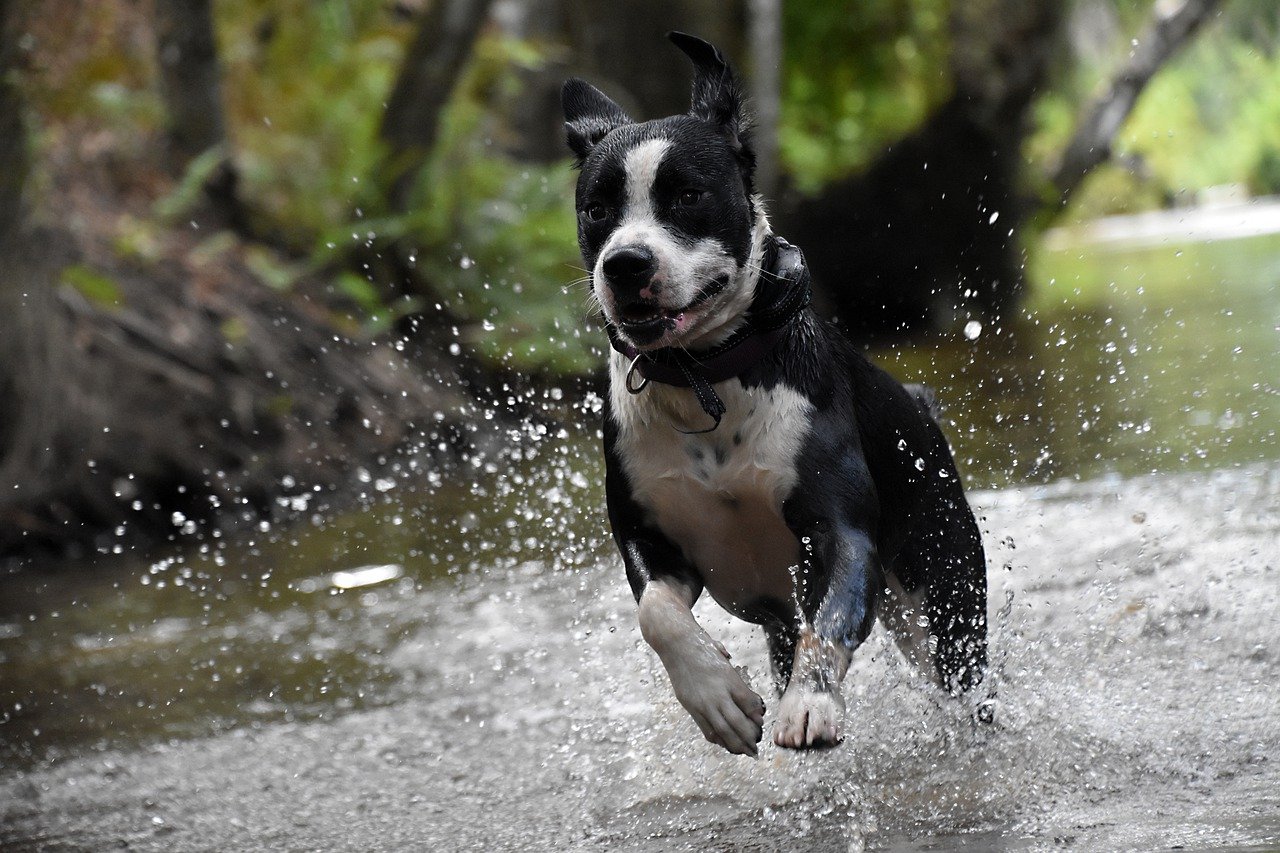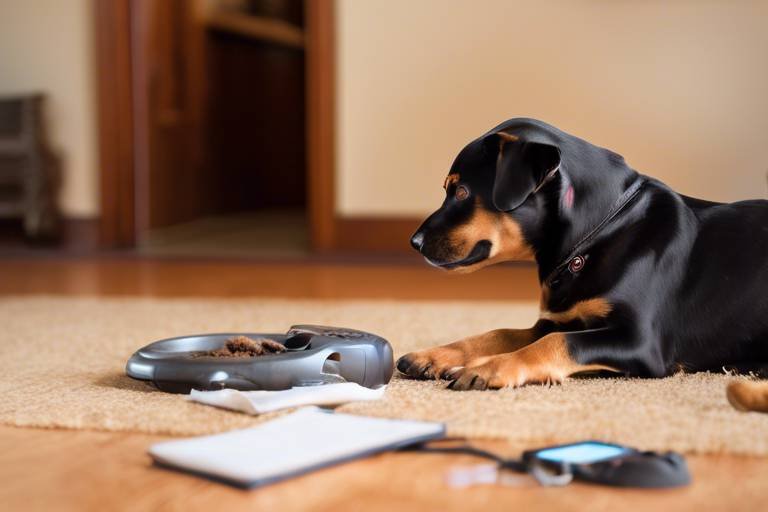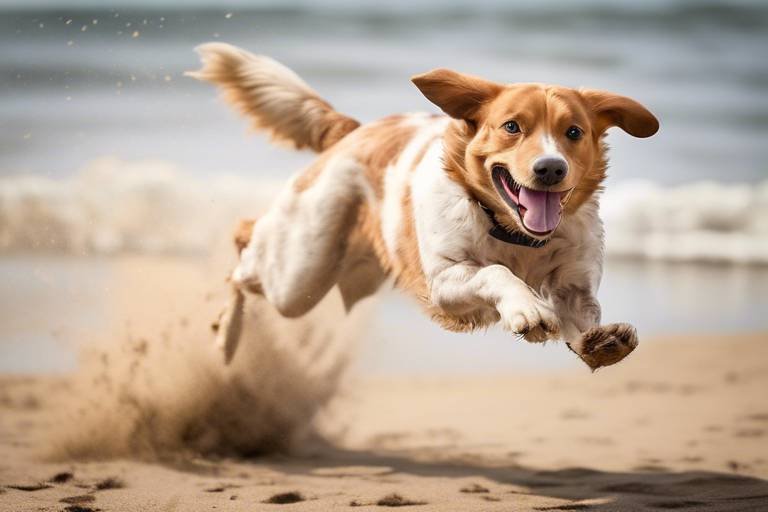The Role of Play in Pet Training
When it comes to training our furry friends, one of the most effective tools we have at our disposal is play. You might wonder, how can something as simple as play contribute to a well-behaved pet? The answer lies in the natural instincts of animals. Play is not just a pastime; it’s a fundamental part of how pets learn and interact with the world around them. By incorporating play into training, we create an environment that is not only enjoyable but also educational.
Imagine a puppy learning to sit. If you simply command "sit" and expect compliance, you might find yourself frustrated. But what if you turn this into a game? Using treats or a favorite toy as a reward for sitting can transform a mundane command into a fun challenge. In this playful setting, the puppy learns to associate the command with a positive outcome, making it more likely to repeat the behavior in the future. This joyful interaction fosters a stronger bond between the pet and the owner, which is essential for effective training.
Moreover, playtime allows for creative training techniques that can cater to the unique personality of each pet. Some pets may thrive in a competitive play environment, while others might prefer a more relaxed approach. By observing how your pet engages with different types of play, you can tailor your training methods accordingly. For example, a high-energy dog might respond better to fetch or agility games, while a more laid-back cat might enjoy puzzle toys that stimulate their curiosity.
In addition to enhancing learning, play serves as a powerful tool for socialization. Pets that engage in group play learn important social cues, such as how to interact with other animals and humans. This can significantly reduce anxiety and aggression, leading to a well-adjusted pet that is comfortable in various social settings. So, the next time you're at the dog park or a pet-friendly gathering, remember that these playful interactions are not just fun—they're crucial for your pet’s development.
Ultimately, the role of play in pet training is about creating a positive, engaging, and effective learning environment. By transforming training sessions into playful experiences, we not only enhance our pets' learning but also enrich our relationships with them. So grab that toy, get ready to play, and watch as your pet blossoms into a well-trained companion!
- Why is play important in pet training?
Play makes training enjoyable and helps strengthen the bond between pets and their owners, leading to more effective learning. - What types of play can I use in training?
Techniques like clicker training, fetch, and hide and seek can make training sessions fun and engaging. - How does play help with socialization?
Group play helps pets learn appropriate behaviors, reducing anxiety and aggression in social settings. - Can play address behavioral issues?
Yes, engaging pets in fun activities can redirect negative behaviors and promote positive habits.

The Importance of Play in Training
Understanding how play can facilitate learning in pets is crucial. When we think about training our furry friends, it’s easy to imagine long sessions filled with commands and corrections. However, integrating play into these sessions transforms the experience for both the pet and the owner. Imagine a world where training is not a chore but a delightful game! This shift not only makes training enjoyable but also strengthens the bond between pets and their owners, leading to more effective training outcomes.
When pets engage in play, they are more likely to be motivated and focused. The joy of playtime encourages them to participate actively, making the learning process feel less like a task and more like a fun adventure. Just think about it: would you rather sit through a dull lecture or engage in an interactive game? The same principle applies to our pets. By incorporating play, we can create an environment that fosters learning.
Furthermore, play serves as a natural stress reliever. Pets, much like humans, can feel overwhelmed or anxious, especially during training. When we introduce play into the mix, it alleviates that pressure and allows our pets to relax. This relaxation translates into better focus and responsiveness, which are essential for effective training. A pet that feels comfortable and happy is more likely to learn and retain commands.
Additionally, play can be a powerful tool for socialization. Engaging in playful activities with other animals and humans helps pets learn appropriate behaviors. For instance, when dogs play together, they learn important social cues, such as when to be gentle and when to assert themselves. This exposure reduces anxiety and aggression in various social settings, making it easier for pets to adapt to new environments.
In summary, the role of play in training cannot be overstated. It not only enhances the learning experience but also strengthens the bond between pets and their owners. By utilizing play as a tool, we can create a positive training environment that encourages growth and development. So, the next time you think about training your pet, remember to sprinkle in some fun!

When it comes to training our furry friends, injecting a little bit of play into the process can make all the difference. Imagine teaching your dog to sit while tossing a ball or getting your cat to come when called with the promise of a feather toy. The beauty of playful training techniques is that they transform mundane commands into exciting games, enhancing both learning and bonding. In this section, we’ll explore some of the most effective playful training methods that you can easily integrate into your pet's training routine.
One of the most popular and effective techniques is clicker training. This method uses a small device that makes a clicking sound to mark the exact moment your pet performs the desired behavior. The click is followed by a reward, usually a treat or a favorite toy. This not only makes the training session fun but also helps your pet associate the sound of the clicker with positive outcomes. Over time, your pet will begin to understand that good things happen when they respond correctly, making them more eager to participate.
Another classic training game that many pet owners love is fetch. This isn’t just a game for dogs; it can also be adapted for cats! Fetch encourages pets to follow commands and provides a fantastic outlet for their energy. The thrill of chasing after a ball or a toy can turn a simple command into an exhilarating experience. Plus, it’s a great way for owners to get some exercise too! Just imagine the joy on your dog's face as they sprint back to you, tail wagging, with their favorite toy in their mouth.
Then we have the delightful game of hide and seek. This playful approach not only teaches pets to follow commands but also sharpens their problem-solving skills. You can start by having your pet stay in one room while you hide in another. Once you’re hidden, call your pet and watch as they use their nose and instincts to find you. This game promotes mental stimulation, and the excitement of the chase keeps them engaged and entertained.
It’s important to remember that play isn’t just about having fun; it also serves a crucial role in socialization. Engaging in play with other pets or humans helps teach appropriate behaviors and reduces anxiety and aggression. When pets learn to interact positively during playtime, they’re better equipped to handle social situations outside of their familiar environment.
In summary, incorporating playful training techniques like clicker training, fetch, and hide and seek into your pet's routine can lead to a more enjoyable and effective training experience. These methods not only make learning fun but also strengthen the bond between you and your pet, resulting in a happier, more well-behaved companion.
- Q: How long should I play with my pet during training sessions?
A: Aim for short sessions of 5-10 minutes, as pets can lose focus. You can have multiple sessions throughout the day. - Q: Can all pets be trained using playful techniques?
A: Yes! Most pets, including dogs, cats, and even some small animals, can benefit from playful training techniques. - Q: What if my pet doesn't seem interested in play?
A: Try different types of toys or activities to find what excites your pet. Some pets may prefer interactive games over traditional toys.
Clicker training is a fantastic way to incorporate play into your pet's training regimen. It’s not just about teaching commands; it’s about creating a fun and engaging environment where your pet can thrive. Imagine the clicker as a magic wand that transforms ordinary moments into exciting learning opportunities! When you click, it’s like saying, “Yes, you did it!” and rewarding your pet instantly. This immediate feedback is crucial because it helps your pet understand exactly what behavior earned them the reward.
But how does it work? The process is simple yet effective. First, you need to condition your pet to associate the sound of the clicker with a treat. Start by clicking the device and immediately giving your pet a small treat. Repeat this several times until your pet starts to look for a treat whenever they hear the click. This creates a positive association that leads to more enthusiastic learning.
Once your pet understands the clicker, you can start using it during training sessions. For example, if you’re teaching your dog to sit, wait for them to perform the action, click, and then reward them. Over time, your pet will begin to associate the action of sitting with the click sound and the subsequent treat, making them more likely to repeat the behavior. This method not only makes learning enjoyable but also strengthens the bond between you and your pet.
Clicker training can be used for various commands and tricks, turning mundane training sessions into exciting games. Here are a few playful ideas to get started:
- Basic Commands: Start with simple commands like sit, stay, or come.
- Advanced Tricks: Once your pet masters the basics, try teaching them fun tricks like rolling over or playing dead.
- Agility Training: Incorporate agility equipment and use the clicker to guide your pet through the course.
Moreover, the clicker can be a powerful tool for reinforcing positive behavior during playtime. For instance, if your dog fetches the ball and brings it back, click and reward them. This not only encourages them to play fetch more often but also reinforces the behavior you want to see. The key is to keep the sessions short and fun, ensuring that your pet remains engaged and eager to learn.
In conclusion, clicker training is not just a method; it’s a playful approach that transforms the training experience for both pets and their owners. By utilizing this technique, you’re not only teaching your pet essential commands but also creating lasting memories filled with joy and connection.
Q1: How long does it take for my pet to learn with clicker training?
A: The time it takes varies by pet, but with consistency and patience, many pets can start responding to commands within a few days to weeks.
Q2: Can I use clicker training for all types of pets?
A: Yes! Clicker training can be effective for dogs, cats, and even some small animals like rabbits and ferrets.
Q3: What if my pet doesn’t respond to the clicker?
A: Ensure your pet has a positive association with the clicker. If they’re not responding, go back to the basics of conditioning them to the sound.
When it comes to engaging your furry friend in a fun and productive way, fetch stands out as a classic game that not only entertains but also serves as a powerful training tool. Imagine the joy on your dog's face as they sprint after a thrown ball, tail wagging with excitement! This simple yet effective game isn't just about retrieving; it's a fantastic opportunity to teach your pet essential commands while keeping them physically active. After all, a tired dog is a happy dog!
Playing fetch goes beyond mere playtime; it creates a dynamic learning environment where your pet can practice obedience in a fun context. When you throw the ball, you're not just initiating a game; you're also giving your pet a command to follow. This reinforces their understanding of commands like "come" and "drop it." The beauty of fetch lies in its ability to combine physical exercise with mental stimulation, making it a win-win for both you and your pet.
To make the most out of your fetch sessions, consider the following tips:
- Start Slow: If your pet is new to fetch, begin with short distances. Gradually increase the distance as they become more comfortable with the game.
- Use High-Value Rewards: Choose toys or balls that your pet loves. This increases their motivation to chase and retrieve.
- Incorporate Commands: Use commands consistently during the game. For example, say "fetch!" when you throw the ball, and "drop it!" when they return.
Furthermore, fetch can be tailored to suit different environments. Whether you're in a spacious park or your backyard, you can adapt the game to fit the space available. You can even play indoors using soft toys if outdoor play isn't an option. Just be mindful of your surroundings to avoid any accidents or damage!
One of the most significant benefits of fetch is the bond it fosters between you and your pet. Each time you play, you're not only teaching them commands but also building trust and understanding. Your pet learns to associate your voice with fun and excitement, which can enhance their overall responsiveness to training. Plus, the satisfaction of watching your pet successfully fetch the ball is incredibly rewarding!
So, next time you're looking for a way to engage your pet, remember that fetch is more than just a game. It's a multifaceted training tool that promotes physical fitness, reinforces obedience, and strengthens the bond between you and your furry companion. Grab that ball and get ready for some fun!
Q: How often should I play fetch with my dog?
A: It's great to play fetch several times a week, but make sure to monitor your dog's energy levels and adjust the frequency based on their needs and preferences.
Q: Can fetch be played with other pets?
A: Absolutely! Cats, for example, can enjoy a similar game with small toys. Just ensure the game is safe and suitable for the specific pet.
Q: What if my dog doesn't retrieve the ball?
A: Some dogs may need time to understand the concept of fetch. Use treats or praise to encourage them, and be patient as they learn!
Playing hide and seek with your pet is not just a delightful way to spend time together; it's also a fantastic training method that stimulates your pet's mind and enhances their problem-solving skills. Imagine this: you're hiding behind the couch, and your furry friend is eagerly trying to find you. This game is more than just fun; it's a way to teach your pet valuable lessons about following scents and responding to commands. Just like children learn through play, pets can develop their cognitive abilities and social skills through engaging activities.
To start this game, you can use a simple command like "stay" while you hide. Once you're hidden, call your pet's name or say "come!" This encourages them to use their sense of smell and hearing to locate you. The thrill of the chase not only keeps them active but also reinforces their listening skills. When they find you, shower them with praise and perhaps a treat, which helps create a positive association with the game.
Moreover, hide and seek can be tailored to suit different skill levels. For beginners, you might want to start by hiding in obvious places and gradually increase the difficulty as your pet gets the hang of it. This progressive challenge keeps your pet engaged and excited, making them more eager to participate. As they improve, you can introduce variations to the game, such as hiding toys or treats instead of yourself, adding an extra layer of fun and challenge.
Incorporating this playful training technique into your routine can yield numerous benefits. It not only strengthens the bond between you and your pet but also promotes mental stimulation, which is crucial for their overall well-being. Just like humans, pets thrive on interaction and engagement, and hide and seek is a perfect way to provide that while also reinforcing important training commands.
- How often should I play hide and seek with my pet?
Playing hide and seek can be done several times a week, depending on your pet's energy levels and interest. It's essential to keep the sessions short and fun to maintain their enthusiasm. - What types of pets can play hide and seek?
While dogs are typically more engaged in this game, many cats and even some small animals can enjoy a version of hide and seek. Tailor the game to your pet's abilities and preferences. - Can hide and seek help with training commands?
Absolutely! This game reinforces commands like "stay," "come," and "search," making it a valuable training tool while also providing mental stimulation.
Playtime is not just fun and games; it serves as a crucial foundation for socializing pets with both other animals and humans. Just imagine a puppy, tail wagging, bounding towards a group of other dogs—this is where the magic happens! Engaging in group play allows pets to learn appropriate behaviors in a safe and controlled environment. Through these interactions, they pick up on social cues, understanding when to be playful and when to be calm. This is vital in reducing anxiety and aggression, as pets learn how to navigate social situations without feeling overwhelmed.
When pets engage in play with others, they are not only having a blast but also developing essential life skills. For instance, during a game of chase, a dog learns to read the body language of its playmates. Is that other dog feeling playful, or is it getting tired? These are important lessons that can translate into better behavior in everyday situations. Additionally, play can help pets establish their own social hierarchy, which is important for their mental well-being.
Furthermore, structured play activities, such as group fetch or tug-of-war, can create a sense of community among pets. Not only does this help in building confidence, but it also fosters a sense of belonging. When pets feel connected to others, they are less likely to exhibit signs of anxiety or aggression. Both the pet and the owner can enjoy the benefits of a well-socialized animal, leading to a more harmonious household.
Incorporating play into socialization efforts can take various forms. For example, dog parks, training classes, and even playdates with friends' pets can provide excellent opportunities for social interaction. Each setting allows pets to engage in different types of play, whether it's roughhousing with other dogs or learning to be gentle around smaller animals. The key is consistency and positive reinforcement; the more often pets are exposed to different social settings, the more adept they become at handling diverse interactions.
In summary, play is an essential tool in promoting socialization among pets. It not only helps them learn vital social skills but also reduces the likelihood of behavioral issues down the line. So, the next time you toss a ball or engage in a game of tug-of-war, remember that you’re doing more than just having fun—you’re preparing your pet for a well-adjusted life!
- How can I tell if my pet is socialized properly? Look for signs of relaxed body language, willingness to engage with other pets, and a lack of aggression or fear in new situations.
- What age should I start socializing my pet? The earlier, the better! Start socializing puppies as young as 3-4 months old to help them develop healthy behaviors.
- Can I socialize an older pet? Yes, while it may take more time and patience, older pets can still learn to socialize effectively through gradual exposure and positive reinforcement.

Incorporating play into obedience training offers a plethora of benefits that can transform the learning experience for both pets and their owners. Imagine trying to teach your dog to sit or stay while they are bored out of their minds—it's not going to end well! However, when you mix in elements of fun, everything changes. Play not only makes the training sessions enjoyable but also enhances the overall effectiveness of the training process.
One of the most significant advantages of using play in obedience training is the improved focus it fosters. When pets are engaged in a fun activity, they are more likely to pay attention and respond positively to commands. For instance, a game of tug-of-war or fetch can serve as a fantastic way to keep your furry friend concentrated on you, rather than getting distracted by the sights and sounds around them. This heightened focus can lead to quicker learning and better retention of commands.
Moreover, play acts as a powerful motivator for pets. Just like humans, pets thrive on rewards, and what better reward than playtime? When you use play as a reward for completing training tasks, it encourages pets to participate willingly. For example, if your dog successfully performs a command, rewarding them with a few minutes of fetch can create a positive feedback loop. They learn that good behavior leads to fun, making them more eager to engage in training sessions.
Additionally, play creates a positive training environment. Training can sometimes feel like a chore, both for the pet and the owner. However, when you introduce play into the mix, it transforms the atmosphere into one of joy and excitement. This positive vibe not only helps in building a strong bond between you and your pet but also makes them more receptive to learning. A happy pet is an attentive pet!
To summarize the benefits of incorporating play into obedience training, consider the following:
- Enhanced Focus: Pets are more attentive during fun activities.
- Increased Motivation: Play serves as a powerful reward, encouraging participation.
- Positive Training Environment: Creates joy and excitement, making training feel less like a chore.
In conclusion, play is not just a leisure activity for pets; it is a vital component of effective obedience training. By recognizing the benefits of play, you can create a training experience that is not only productive but also enjoyable for both you and your furry friend. So, the next time you gear up for a training session, remember to bring along some fun!
Q: How can I incorporate play into my pet's training?
A: You can incorporate play by using games like fetch or tug-of-war as rewards for completing commands. This keeps your pet engaged and motivated.
Q: What types of play are best for training?
A: Interactive games that require your pet to follow commands, such as fetch or hide-and-seek, are excellent for training. These games promote both physical and mental engagement.
Q: Can play help with behavioral issues?
A: Absolutely! Engaging your pet in play can redirect negative behaviors and promote positive habits, making it a valuable tool for addressing behavioral issues.
When it comes to pet training, focus is a game changer. Imagine trying to teach your dog a new trick while they’re distracted by a squirrel outside or a butterfly fluttering by. It can be a real challenge! This is where the magic of play comes into play—literally! Incorporating fun activities into training sessions not only captures your pet's attention but also keeps them engaged and eager to learn. Just like how kids are more likely to pay attention in a classroom when the teacher makes learning fun, pets respond similarly to playful training methods.
One of the best ways to enhance focus is to integrate interactive games that require your pet to pay attention and respond to commands. For instance, using a toy that dispenses treats can be a fantastic way to keep your pet focused. As they play, they learn to associate the fun of the game with following your commands. This creates a positive feedback loop where the more they focus, the more they are rewarded. It’s a win-win situation!
Another effective technique is to utilize short training sessions filled with playful elements. Instead of long, tedious practices that can lead to boredom, try keeping sessions brief—around 5 to 10 minutes. During these sessions, include a variety of playful tasks, such as:
- Using a clicker to mark desired behaviors during play
- Incorporating fetch or tug-of-war to reinforce commands
- Changing up the toys and games to maintain interest
By keeping the atmosphere light and fun, you create an environment where your pet is less likely to zone out. This not only improves their focus but also makes them look forward to training time. It’s like turning a chore into a party!
Additionally, don't underestimate the power of environmental enrichment. Setting up a training area filled with different textures, toys, and even scents can stimulate your pet’s senses, making them more alert and focused. It’s akin to a child learning better in a colorful and engaging classroom versus a dull, lifeless one.
In summary, enhancing focus through play is about making training enjoyable and stimulating for your pet. By incorporating fun activities, keeping sessions short, and enriching the environment, you can significantly boost your pet’s attention span and eagerness to learn. So, the next time you grab that training leash, remember: it’s not just about commands; it’s about creating a playful, engaging experience that both you and your pet will cherish.
Q: How long should play-based training sessions last?
A: It's best to keep sessions short, around 5 to 10 minutes, to maintain your pet's attention and enthusiasm.
Q: Can any type of play be incorporated into training?
A: Absolutely! Activities like fetch, tug-of-war, and interactive toys can all be effective in reinforcing commands.
Q: What if my pet gets distracted during training?
A: If distractions occur, try to refocus their attention with a favorite toy or treat, and consider adjusting the training environment to minimize distractions.
Q: Is play beneficial for all types of pets?
A: Yes! Play is beneficial for dogs, cats, and even smaller pets like rabbits and guinea pigs, as it helps with bonding and learning.
This article explores the significance of play in effectively training pets, highlighting various techniques and benefits that can enhance the training experience for both pets and their owners.
Understanding how play can facilitate learning in pets is crucial. It not only makes training enjoyable but also strengthens the bond between pets and their owners, leading to more effective training outcomes.
Various playful training techniques can be employed, such as clicker training and fetch games. Each method utilizes play to reinforce positive behaviors, making learning a fun and engaging process for pets.
Clicker training is an effective way to incorporate play into pet training. By associating the sound of a clicker with rewards, pets learn to respond positively during playtime.
Fetch is not just a game; it's a powerful training tool. This activity encourages pets to follow commands while also providing physical exercise, making it a win-win for both pet and owner.
Playing hide and seek with pets can enhance their problem-solving skills. This game teaches them to follow scents and commands, promoting mental stimulation while having fun.
Playtime is essential for socializing pets with other animals and humans. Engaging in group play helps pets learn appropriate behaviors, reducing anxiety and aggression in various social settings.
Incorporating play into obedience training offers numerous benefits, including improved focus, increased motivation, and a more positive training environment, which ultimately leads to better-trained pets.
Play helps maintain a pet's attention during training sessions. By integrating fun activities, pets are more likely to stay engaged and responsive to commands, leading to efficient learning.
Using play as a reward for completing training tasks keeps pets motivated. This positive reinforcement encourages them to participate willingly, making the training process smoother and more enjoyable. When pets associate the training with fun activities, their eagerness to learn increases significantly. For instance, consider how a child reacts to a reward system; the same principle applies to pets. By offering treats, praise, or even a few extra minutes of playtime, you can create a powerful incentive for your furry friend to engage in training.
Moreover, the effectiveness of rewards can be enhanced by varying the types of rewards based on your pet's preferences. Some pets might respond better to physical toys, while others may be more motivated by tasty treats. Understanding your pet's unique likes and dislikes is crucial. Here's a quick breakdown:
| Type of Reward | Best For |
|---|---|
| Food Treats | Food-motivated pets |
| Interactive Toys | Active pets |
| Verbal Praise | Affectionate pets |
| Extra Playtime | High-energy pets |
By tailoring your rewards to fit your pet’s personality, you can keep their enthusiasm high and make training sessions something they look forward to. This not only enhances their learning experience but also fosters a deeper bond between you and your pet, transforming the training process into a shared adventure filled with joy and discovery.
Play can be an effective strategy for addressing behavioral problems in pets. Engaging them in fun activities can redirect negative behaviors and promote positive habits through consistent reinforcement.
Aggressive behaviors can often be mitigated through structured play. By channeling energy into interactive games, pets learn to socialize better and reduce aggressive tendencies.
Play serves as a natural anxiety reliever for pets. Engaging in playful activities helps alleviate stress, making pets more relaxed and receptive during training sessions.
- How often should I incorporate play into training? It's best to include play in every training session, even if it's just for a few minutes. This keeps the experience positive and engaging.
- What types of rewards work best for my pet? It varies by individual pet. Experiment with treats, toys, and praise to see what motivates your pet the most.
- Can play help with behavioral issues? Yes! Play can redirect negative behaviors and help pets learn appropriate social skills.

When it comes to our furry friends, behavioral issues can sometimes feel like a mountain to climb. But here’s the good news: play can be a powerful tool in tackling these challenges! Engaging your pet in fun activities not only serves as a distraction but also helps to redirect their energy into more positive behaviors. Think of play as a magic wand that transforms negative habits into delightful interactions. Whether your pet struggles with aggression, anxiety, or any other behavioral hiccup, incorporating play can lead to remarkable improvements.
For instance, if your dog tends to get a bit nippy or overly excited during playtime with other dogs, structured play can help them learn appropriate social cues. By engaging them in games like tug-of-war or fetch, they can practice self-control and learn when to be gentle. The key is to create an environment where they can express their energy in a safe and constructive way. This not only teaches them how to behave but also reinforces the bond you share.
Moreover, structured play can significantly reduce anxiety in pets. Just like humans, pets can experience stress, and play acts as a natural remedy. When you engage your dog in a game of chase or your cat in a playful pounce with a feather toy, you’re not just having fun; you’re also helping them alleviate stress. This playful interaction releases endorphins, which can create a sense of happiness and relaxation. As a result, your pet becomes more receptive during training sessions, making it easier to address any lingering behavioral issues.
To illustrate the impact of play on behavioral issues, let’s take a look at a simple comparison table:
| Behavioral Issue | Play Technique | Expected Outcome |
|---|---|---|
| Aggression | Interactive Games | Improved Social Skills |
| Anxiety | Fetch or Tug-of-War | Reduced Stress Levels |
| Excessive Barking | Hide and Seek | Enhanced Focus |
By utilizing these playful techniques, you can effectively address common behavioral problems. Remember, the goal is to create a positive learning environment where your pet feels safe and engaged. Consistency is crucial; the more you incorporate play into your training regimen, the better your pet will respond. It’s like building a bridge of trust and understanding, allowing you to guide them toward better behavior.
Ultimately, addressing behavioral issues through play is not just about correcting unwanted actions; it’s about enriching your pet’s life and deepening your relationship. So, next time you face a challenge with your furry companion, grab a toy, and let the games begin!
- Can all pets benefit from play-based training? Yes! Most pets, including dogs, cats, and even small animals like rabbits, can benefit from play-based training techniques.
- How often should I incorporate play into training sessions? Aim to include play in every training session, but keep it balanced. Too much play can lead to distraction, while too little can make training feel tedious.
- What types of play are best for addressing aggression? Interactive games that require teamwork, like fetch or tug-of-war, can help channel aggressive energy into positive interactions.
- Is it possible to overdo it with play? Yes, moderation is key. Always watch for signs of overstimulation or fatigue in your pet, and adjust the playtime accordingly.
When it comes to our furry friends, aggression can be a significant concern for many pet owners. However, what if I told you that play could be the key to redirecting this behavior? Engaging in structured, interactive play can be a game-changer, transforming aggressive tendencies into positive interactions. Think of play as a bridge that connects the gap between frustration and fun. By channeling their energy into enjoyable activities, pets can learn to express themselves in healthier ways.
One effective strategy is to incorporate toys that promote interactive play. For instance, using tug toys can not only satisfy a pet's urge to bite but also teach them about boundaries and control. During these play sessions, it's crucial to establish rules. When your pet gets too rough, a simple pause in the game can signal that such behavior is unacceptable. This teaches them that aggression leads to a loss of fun. Over time, they will learn to moderate their energy levels and play more gently.
Additionally, consider the environment in which you engage your pet. A calm and controlled setting can significantly impact their behavior. For example, if your dog tends to be aggressive towards other dogs, introducing them to a playgroup in a neutral space can help. Here, they can learn to socialize under supervision, gradually understanding how to interact without resorting to aggressive behaviors. This method not only allows for physical exercise but also provides mental stimulation, which is vital for reducing anxiety and aggression.
Moreover, it's essential to monitor your pet's body language during play. Signs of aggression can manifest in various ways, such as growling, stiffening, or showing teeth. Recognizing these signals early can help you intervene before things escalate. Instead of allowing aggressive play to continue, redirect their focus onto a toy or a different activity. This redirection not only diffuses tension but also reinforces the idea that play should be fun and safe.
In summary, redirecting aggression through play is about creating a positive experience that fosters learning and socialization. By using interactive toys, establishing rules, and being mindful of your pet's behavior, you can turn potential aggression into playful moments. Remember, the goal is to create a safe space where your pet can express themselves without fear of reprimand. With patience and consistency, you will see a transformation in their behavior, paving the way for a harmonious relationship.
- Can all pets benefit from play to reduce aggression? Yes, most pets can benefit from structured play. However, it's essential to tailor activities to fit their personality and energy levels.
- How long should play sessions be? Aim for 15-30 minutes of interactive play, depending on your pet's stamina and interest. Short, frequent sessions can be more effective than long ones.
- What types of toys are best for redirecting aggressive behavior? Interactive toys like tug ropes, balls, and puzzle toys are excellent choices as they engage your pet mentally and physically.
- Is it safe to let my pet play with other animals? Supervised play with other pets can be beneficial, but always monitor their interactions to ensure safety and prevent aggressive behavior.
When it comes to our furry friends, anxiety can be a significant hurdle that affects their behavior and overall well-being. Just like humans, pets experience stress and anxiety, whether it's from loud noises, unfamiliar environments, or separation from their owners. Thankfully, play emerges as a powerful tool to combat these feelings. By engaging in fun and interactive activities, pets can channel their pent-up energy and emotions into something positive. This not only helps alleviate stress but also fosters a sense of security and happiness.
Think of play as a natural remedy for anxiety. Imagine your pet, feeling overwhelmed by the world around them. Now, picture them in a playful environment, where they can run, jump, and engage with you. This transformation is crucial. Playtime acts as a distraction, redirecting their focus from stressors to enjoyable activities. In fact, studies have shown that pets who engage in regular play are less likely to exhibit signs of anxiety and aggression. It's like giving them a mental reset button!
Moreover, the physical activity involved in play releases endorphins, the body's natural stress relievers. This biochemical reaction not only elevates their mood but also promotes overall health. Whether it's a game of tug-of-war or a simple game of fetch, the benefits are undeniable. But how do you know if your pet is ready to play? Look for signs such as wagging tails, playful barks, or even a playful pounce. These are indications that your pet is ready to engage and benefit from the joy of play.
Here are some effective play strategies to help relieve your pet's anxiety:
- Interactive Toys: Toys that require your pet to think and engage can be particularly effective. They stimulate your pet's mind and keep them occupied.
- Outdoor Play: Taking your pet outside for a run or a game of fetch can significantly reduce anxiety levels. The fresh air and change of scenery work wonders!
- Routine Playtime: Establishing a regular playtime schedule can create a sense of predictability for your pet, helping them feel more secure.
Incorporating these playful activities into your pet's routine not only alleviates anxiety but also strengthens the bond between you and your furry companion. Remember, a happy pet is a well-adjusted pet. By prioritizing play, you're not just training your pet; you're enhancing their quality of life.
Q: How often should I play with my pet to alleviate anxiety?
A: Ideally, you should engage in play sessions with your pet daily. Even short bursts of play can make a significant difference in their anxiety levels.
Q: What types of play are best for anxious pets?
A: Interactive play, such as fetch or tug-of-war, is great. Additionally, puzzle toys can help keep their minds occupied and distracted from anxiety triggers.
Q: Can too much play be harmful?
A: While play is beneficial, it’s important to monitor your pet’s energy levels. Overexertion can lead to fatigue or injury. Always ensure that playtime is balanced with rest.
Q: What if my pet doesn't seem interested in play?
A: If your pet is reluctant to engage, it might be a sign of underlying anxiety or stress. Consider consulting a veterinarian or a pet behaviorist for tailored advice.
Frequently Asked Questions
- Why is play important in pet training?
Play is crucial in pet training because it makes learning enjoyable for pets. It helps strengthen the bond between pets and their owners, leading to more effective training outcomes. When pets associate training with fun, they are more likely to engage and respond positively to commands.
- What are some playful training techniques I can use?
There are several playful training techniques, including clicker training, fetch games, and hide and seek. Each of these methods incorporates play to reinforce positive behaviors, making the training process fun and engaging for your pet.
- How does clicker training work?
Clicker training involves using a clicker to mark desired behaviors. When your pet performs a command correctly, you click the device and then provide a reward. This helps pets understand what actions earn them treats or praise, making training a playful experience.
- Can fetch be used as a training tool?
Absolutely! Fetch is not just a game; it serves as an effective training tool. It encourages pets to follow commands while also providing them with physical exercise, making it a beneficial activity for both pets and their owners.
- How can play promote socialization in pets?
Engaging in playtime with other animals and humans is essential for socializing pets. Group play helps them learn appropriate behaviors, reducing anxiety and aggression in social settings. It teaches them how to interact positively with others.
- What benefits does play offer in obedience training?
Incorporating play into obedience training can lead to improved focus, increased motivation, and a more positive training environment. These factors ultimately contribute to better-trained pets who are eager to learn and respond to commands.
- How can play help address behavioral issues in pets?
Play can effectively redirect negative behaviors in pets. Engaging them in fun activities can shift their focus and promote positive habits through consistent reinforcement, making it easier to manage behavioral problems.
- Can play help reduce aggression in pets?
Yes! Structured play can help mitigate aggressive behaviors. By channeling their energy into interactive games, pets learn to socialize better, which can significantly reduce aggressive tendencies over time.
- Is play beneficial for pets experiencing anxiety?
Definitely! Play serves as a natural anxiety reliever. When pets engage in playful activities, it helps alleviate stress, making them more relaxed and receptive during training sessions.



















